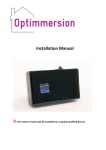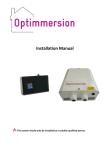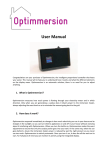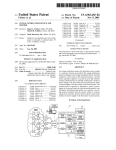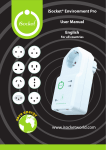Download Big Energy Upgrade Computer Science Final Report
Transcript
BIG Energy Upgrade Work Package 3 Energy Consumption: Monitoring and Feedback Authors Dr Stuart N. Wrigley Professor Fabio Ciravegna Neil Ireson Dr Simon Tucker Publication Date February 2014 Publisher University of Sheffield Copyright © 2013, 2014 The University of Sheffield All rights reserved. No part of this report may be reproduced, adapted, stored in a retrieval system or transmitted by any means, including photocopying, recording, or other electronic or mechanical methods without the prior written permission of the publisher. For permission request, please contact: Professor Fabio Ciravegna [email protected] Professor Fabio Ciravegna Department of Computer Science University of Sheffield 211 Portobello Sheffield S1 4DP United Kingdom 2 BIG Energy Upgrade Energy Consumption: Monitoring and Feedback Dr Stuart N. Wrigley Professor Fabio Ciravegna Neil Ireson Dr Simon Tucker 3 Acknowledgements This work has been undertaken by the University of Sheffield as a part of the WorkPackage 3 of the BIG Energy Upgrade programme (aka Energy Innovation for Deprived Communities). The BIG Energy Upgrade is a flagship £15.5 million programme, part financed by the European Union Regional Development Fund (ERDF) through the Yorkshire and Humber ERDF Programme 2007-13, addressing the priority needs of reduction in carbon emissions and creation of jobs. To address the issues in an integrated approach the University of Sheffield has brought together a multidisciplinary team of academics who are working alongside Local Authorities, ALMOs, social housing providers and an energy services company in delivering this project. The University of Sheffield would like to thank the Local Authorities that have taken part in this research, namely: Barnsley MBC, Doncaster MBC, Kirklees Council, Leeds City Council, North Lincolnshire Council and North East Lincolnshire Council. The University of Sheffield would like to extend particular thanks to Anthony Wright, Neighbourhood Energy Officer for Doncaster MBC for his time and effort during the participant recruitment phases. Our appreciation also goes to their Housing Partners (Berneslai Homes, Kirklees Neighbourhood Housing, North Lincolnshire Homes, St Leger Homes, West North West Homes Leeds) and Management Partners (NPS Barnsley, Leeds ALMO Business Centre) which have also contributed to the University's work. 4 Contents ACKNOWLEDGEMENTS 4 CONTENTS 5 1 INTRODUCTION 7 2 IN-HOME MONITORING TECHNOLOGY 9 2.1 STATE OF THE ART 2.1.1 ELECTRICITY MONITORING 2.1.2 GAS MONITORING 2.1.3 REMOTE MONITORING 9 10 11 12 2.2 PHASE 1 INSTALLATIONS 13 2.3 PHASE 2 INSTALLATIONS 2.3.1 LOGGING AND COMMUNICATIONS 2.3.2 GAS MONITORING 2.3.3 INDEPENDENT CONNECTIVITY 2.3.4 SUMMARY OF EQUIPMENT 13 14 15 21 22 2.4 STAND-ALONE EQUIPMENT 22 2.5 PARTNER-BASED MONITORING 23 RESIDENT FEEDBACK TECHNOLOGY 24 3 4 3.1 STATE OF THE ART 3.1.1 REAL-TIME DISPLAY 24 25 3.2 DATA ANALYSIS AND STORAGE SERVER 3.2.1 WEATHER DATA 3.2.2 COSTINGS 3.2.3 IMPLEMENTATION 25 25 25 26 3.3 API 29 3.4 WEB-BASED CONSUMPTION BROWSER 3.4.1 HOMEPAGE 3.4.2 NAVIGATION 3.4.3 TODAY'S CONSUMPTION 3.4.4 THIS WEEK'S CONSUMPTION 3.4.5 FULL HISTORY 3.4.6 USER MANUAL 30 32 34 34 38 39 41 3.5 DATA SNAPSHOT 41 MONITORING RECRUITMENT EXPERIENCES 4.1 RECRUITMENT 44 44 5 4.2 LOGISTICAL ISSUES 5 6 KEY FINDINGS AND RECOMMENDATIONS 45 47 5.1 MONITORING TECHNOLOGY 47 5.2 FEEDBACK 48 5.3 PARTICIPANT RECRUITMENT AND INTERACTION 49 REFERENCES 52 7 APPENDIX - HOUSE SELECTION DOCUMENTATION FOR PARTNER-BASED ENERGY CONSUMPTION MONITORING 54 6 1 Introduction The increasing pressure to make rapid and substantial reductions in greenhouse gas emissions in order to mitigate dangerous climate change (see IPCC, 2007; UNFCCC, 2009) requires considerable changes to the way that energy is generated and used. These changes will depend, in part, on shifts in the way that the general public think about and use energy in the home, and their willingness to adopt or facilitate interventions and policies aimed at reducing energy demand. In the UK, as in other countries (e.g., Australia, Italy, United States, France, Ireland), it is anticipated that the rollout of in-home smart-metering technology should help to reduce household energy consumption (see DCLG, 2010; DECC, 2011). In short, it is hoped that the real-time energy-use feedback that can be provided to householders via in-home display units or ‘smart-monitors’ associated with smart meters should help to improve public awareness of the pattern and cost of their energy-use behaviour, resulting in enhanced ‘energy literacy’ and decreased energy consumption (see Darby, 2006). That clear feedback is a necessary step towards educating consumers with regard to their energy consumption has been identified by several pieces of research (e.g. Darby, 2006; Fischer, 2008; Gans et al., 2011; Pierce et al., 2008). The nature of successful feedback and the method by which success is identified is, however, less clear. The majority of home energy monitors provide real time consumption data, research demonstrating that this level of feedback is effective (e.g. Ueno, 2005). However, more complex feedback technologies have either not received the same level of analysis (e.g. Petersen, 2009) or have been largely unsuccessful (e.g. Google PowerMeter1). The fundamental aim of the energy monitoring activity within the BIG Energy Upgrade project is the empowerment of residents and communities so that they may contribute to the energy usage reduction objectives and, in turn, reduce expenditure and CO2 emissions. Specifically, Task 1 focussed on the implementation of remote monitoring of energy consumption in houses (electricity, gas, etc.) via broadband. The work performed to achieve this goal is described in Chapter 2. Houses were monitored over secure, encrypted connections which effectively formed a virtual private network connecting households' monitoring equipment and the University of Sheffield’s servers via the public Internet. Although initially intended to leverage South Yorkshire's Digital Region superfast broadband, the failure of this initiative 2 meant that low-level connectivity was via the homeowner's personal domestic broadband. The data collected was analysed to provide personal profiles of energy usage which were fed back to users (see Task 3). Due to the unexpectedly low level of up-take (see Chapter 4), insufficient data was available to analyse cross-regional profiles according to the type of accommodation, family, etc. In order to achieve the latter, monitoring equipment would have to have been installed in a number of households for each type of accommodation and each size of family and each representative geographical location, etc. - something the low level of recruitment precluded. Task 3 focussed on the provision of personalised energy-use feedback to 1 http://www.google.com/powermeter/about/ BBC News: South Yorkshire's Digital Region broadband scheme to close http://www.bbc.co.uk/news/uk-england-south-yorkshire-23713493 2 7 residents. This work is described in Chapter 3. Consumption information is provided at a range of granularities and allows comparison between different points in time. Although it was originally envisaged to provide participants with the opportunity of comparing their consumption with other families living in similar households, data privacy and ethical concerns meant that individual households were restricted to viewing only their own consumption patterns. The households participating in the project are likely to have low incomes and therefore use less energy and produce less CO2 than households with higher income (Hirsch et al., 2011; Reinders et al., 2003; Wier et al., 2001). However, such households tend to devote a greater share of their spending to fuel and water than higher-income households. In 2009, the poorest 10 per cent of households (i.e. the lowest ‘income decile’) spent on average over twice as much of their budget on fuel compared with the highest income decile (7.7% and 3.4%, respectively; Baker, 2011). Therefore these households are at a greater risk of falling into fuel poverty, although the exact definition of which households are in fuel poverty is under current debate the general concept is defined as a function of "the amounts by which the assessed energy needs of fuel poor households exceed the threshold for reasonable costs" (Hills, 2012). While income is the primary determinant of energy consumption and carbon emissions, other factors such as the type of dwelling, tenure, household composition and rural/urban location are also extremely important (Druckman and Jackson, 2008) - some of which as addressed in other areas of BIG Energy Upgrade project's work. The remainder of this document focuses on the monitoring technology deployed, the feedback approaches adopted and our experiences of participant recruitment. Section 2 address monitoring equipment by investigating the state of the art for both electricity and gas monitoring devices (Section 2.1); the technology used in phase 1 (Section 2.2) and phase 2 (Section 2.3); and finally discusses equipment for standalone deployment of monitoring equipment (Section 2.4) and the support for partner-based monitoring (Section 2.5). Section 3 describes the resident feedback technologies by providing an overview of the state of the art (Section 3.1); the supporting technology for storing and analysing the consumption data (Section 3.2); a standards-compliant approach for accessing the data (Section 3.3) and finally a user-friendly web-based application for exploring a resident's energy consumption behaviour (Section 3.4). Section 4 details our experiences related to the participant recruitment process and Section 5 concludes with a number of key findings and recommendations. 8 2 In-Home Monitoring Technology This work focussed on the collection of data on energy usage patterns. Cost-effective monitoring was achieved by remote monitoring via broadband thus allowing the monitoring of dwellings from across the region, subject to availability of broadband access. Houses were monitored via the creation of encrypted virtual communication channels able to carry sensor data to a central server located within the University while providing security and privacy (see Figure 1). Participant's home Electricity University of Sheffield Data analysis Gas Internet Data logging and communication Data access server & web server Figure 1. Data flow between monitored houses and the University. Note all communications are secure. Participant selection and recruitment was subject to a number of caveats and was made in collaboration with the other work packages (e.g., the team from architecture investigating changes in air quality). More details of this can be found in Section 4. Once the sensors were installed, the collected consumption data was analysed to provide personal profiles of energy consumption which were fed back to users (see Section 3). For the BIG Energy Upgrade project three core technology requirements were identified: 1. 2. 3. ability to monitor electricity and gas, ability provide a real-time display (RTD) for in-home monitoring and ability to transmit household energy consumption to remote servers for monitoring and feedback 2.1 State of the Art At the start of the project, a review of the state of the art energy consumption monitoring equipment was made. In addition to the technological requirements mentioned above, it was important that any system was cost effective in order for the project to afford to install full monitoring kits in a range households. Table 1 details the eight leading devices and providers (correct at time of compiling - Summer 2011) of current energy 9 consumption monitoring systems available to the general public and their applicability to the BIG Energy Upgrade requirements. Table 1. Applicability of Currently Available Energy Consumption Monitoring Systems to BIG Energy Upgrade Requirements. System ISA iMeter Current Cost Owl Eco-eye SaveOmeter Watson Alert Me Efergy Elec Gas Elec RTD Gas RTD Net Log Website Cost (£) www.isa.pt www.currentcost.com www.theowl.com www.eco-eye.com www.saveometer.com www.diykyoto.com/uk www.alertme.com www.efergy.eu 275 50 41 44 107 139 50 54 Table 2 shows a number of other monitoring systems which not yet available or available via specific utility providers. Table 2. Applicability of Other Energy Consumption Monitoring Systems to BIG Energy Upgrade Requirements. System GEO Ewgeco Onzo British Gas 2.1.1 Elec Gas Elec RTD Gas RTD Net Log Website www.greenenergyoptions.co.uk www.ewgeco.com onzo.com www.britishgas.co.uk Electricity Monitoring All the publicly available electricity consumption smart meters use the same basic technology. A sensor clips on to the mains power cable connected to the electricity meter; this monitors the instantaneous electrical current (amperes) passing through the cable via the magnetic field generated around the power cable. The sensor is plugged into a transmitter which sends the readings wirelessly to the display unit (see Figure 2). 10 Figure 2. Electricity monitoring clamp and transmitter fitted in a domestic electricity meter box. 2.1.2 Gas Monitoring The monitoring of gas consumption is more problematic, due to this domestic smart metering systems are almost universally aimed at solely monitoring electricity. The possible approaches to monitoring gas consumption depend upon the gas meter type used: Pulse-Enabled Meters - these devices produce an electric pulse therefore simply require the connection of a data logger or wireless transmitter. Pulse-Ready Meters - these meters generate a magnetic pulse which requires converting into an electric pulse via the use of a Hall Effect Sensor or Reed Switch (the latter encapsulated into a 'pulse block'). Meters with Dials - for meters with spinning dials it is possible to count the rotation of the lowest unit dial. This can be done using a photo-reflector which transmits an LED light and senses the reflection. Some meters have a small reflective disc on the dial. There are a number of issues with this approach: it will require covering the dial with a fairly robust framework, so that the sensor does not move, limiting the ability to take a visual reading and it is sensitive to light noise. Meters with Numeric Index - Finally if no pulse can be acquired from the meter it is possible to use Optical Character Recognition (OCR) technology to process the image of the display to calculate the meter reading. In general the commercial 11 versions of such technology is expensive (e.g. around £300 for the Xemtec system10), however it does provide a fairly universal way of reading any meter. A further issue encountered in the project was the use of Prepayment or Credit Meters. Such meters utilise the magnetic signal to calculate consumption and so the signal is unavailable for the smart meter. One, somewhat radical solution to this issue was to install a secondary meter to provide another pulse. However compared to the cost and technical complexity of other solutions (i.e. using OCR), secondary meters are more economical and straightforward. As of Spring / Summer 2012, there was no reliable solution which was both commercially available and met the BIG Energy Upgrade projects' requirements (for gas as well as electricity). For instance, Ewgeco (http://www.ewgeco.com) produces an award winning, real-time energy display device, which is the only 3 utility (including micro generation) display accredited by the Code for Sustainable Homes, where builders gain 2 credits under section ENE 3. However, even this 'prosumer' / industrial level product only supports a small subset of gas meters - those based on magnetic pulse outputs (http://www.ewgeco.com/downloads/document/get/Ewgeco_Gas_Meter_Connect ion_Guide.pdf). Furthermore, the cost of £550 per unit was prohibitive given the number of installations required. UPL Meter Mimic device (http://www.up-ltd.co.uk/services/metering/metermimic) is designed for industrial scale installations rather than domestic metering and again relies on magnetic pulse enabled equipment (and in some cases, uses optical sensor technology). This is an expensive option. The SaveOmeter has recently offered gas monitoring (http://www.saveometer.com/gas_monitor.aspx) but there is no facility for data upload or logging. Current Cost was working on a gas monitoring solution compatible with the EnviR units. However, Current Cost were contacted twice during August and both times the response was that these were still under development and are not yet available3. It ought to be noted that the vast majority of gas monitoring solutions - even the 'premium' ones - are only compatible with pulse-ready and pulse-enabled meters. 2.1.3 Remote monitoring For remote monitoring it is necessary to connect the in-home display to some transmitter over the Internet. Most systems provide some proprietary hardware which is hardcoded to send information to the manufacturer's data servers. These approaches vary in their ability to deal with communication outages, for example the ISA iMeter does not store any data so any outage will lose data. The AlertMe system has a ten day data buffer alleviating, to some extent, the network issues encountered. 3 The Current Cost gas monitoring solution was finally released mid- to late-Summer 2013: too late for deployment by the BIG Energy Upgrade project. 12 2.2 Phase 1 Installations The initial decision was to use the ISA iMeter Kit as this was the only equipment available which specifically claimed to monitor both gas and electricity. In retrospect this decision was mistaken. While the kit did in theory provide the ability to meet the project requirements, in-the-field trials identified a number of drawbacks which severely limited its practicality in the actual real-world households: The version of the RTD used is the Efergy Classic 1.0. While this does have the benefit of being small and battery powered, and is therefore both convenient to be situated in the home and is not reliant on proximity to mains power, it did not provide any data logging. This means that if the unit loses remote connection, either within the home (i.e., between the RTD and the electricity sensor) or from the home to the data servers (i.e., between the RTD and the server), then all the data is irretrievably lost. Indeed, despite significant effort, the gas monitoring sensor could not be made to communicate with the RTD. Furthermore, it was observed that the network connection hardware/software was not robust: the monitoring devices regularly failed to either initialise or (in cases when a connection could be made) maintain a connection to the data server. Together, these issues resulted in a system that was ineffective in providing in-home, real-time feedback of electricity consumption and ineffective in transmitting data back to the central server. Both of these requirements are majors factor in the effectiveness of smart meters. 2.3 Phase 2 Installations In order to address the problems associated with the ISA equipment, alternative monitoring kits were re-evaluated. Despite the lack of native support for monitoring gas consumption (i.e., no commercially-available Current Cost device for monitoring gas consumption), the Current Cost EnviR device was selected. There were a number of reasons for this choice: 1. More detailed realtime feedback via the RTD 2. Consumption data easily available via USB from RTD 3. Potential to create bespoke gas monitoring device compatible with the EnviR Although the EnviR's RTD requires mains power (the company claim this is more environmentally friendly than using batteries) it does provide more complex feedback. The possibility to download consumption data directly from the RTD via USB can be utilised to address the prevention of data loss. These aspects are described in more detail below. The Current Cost EnviR package consists of: EnviR receiver and RTD Electricity monitoring clamp Electricity monitoring transmitter Data cable When the monitoring clamp is fitted around the mains cable in the electricity meter cabinet and connected to the transmitter, instantaneous 13 electricity consumption is displayed on the EnviR RTD. The instantaneous consumption reading (for electricity) is updated every 6 seconds. The RTD provides additional basic information such as a cost estimate and coarse historical consumption. 2.3.1 Logging and Communications Current Cost also provide internet connection hardware (NetSmart for sending data to Current Cost servers), however there had been concerns about it’s robustness and given both the need for a reliable logging of data and remote connection to the University (rather than Current Cost) the decision was made to a device which would allow custom logging and custom data communications. It is not uncommon for Internet connections to become unavailable (connection lost, router unplugged, etc.). Indeed, it has been observed that some users only switch their router on when they need to use the Internet. Therefore, it is not possible to rely on an Internet connection with constant availability. Some monitoring devices (such as the ISA iMeter) have no on-board storage facility and thus when the Internet connection fails, all data is lost until the connection is restored. In the case of the Current Cost EnviR device, a limited degree of logging on the RTD is available but of insufficient granularity for the purposes of the BIG Energy Project requirements: the EnviR's native historic readings are aggregated which means there will be some information loss if the data is not transmitted before aggregation. To address this issue, ways of storing the consumption data locally (i.e., in the participant's house) until an Internet connection was available were investigated. The Current Cost EnviR provides data access via a USB cable which can be used to download consumption data to a Windows or Linux PC. In light of this, it was decided to use a small, low-power mini-PC (a Viglen MPC-L) running Linux. This device provides 80Gb of storage (sufficient to capture many years of energy consumption data), 4 USB ports (capable of connecting to the EnviR) and Ethernet connectivity (to connect, via the participant's router, to the Internet). The Viglen mini-PC is very small (about the size of 3 stacked CD cases) and consumes very little energy (costing about £1 per year to run when switched on continuously). A suite of custom-made software modules was created in order for the Viglen PC to handle all of the data logging and secure data transmission. The Viglen mini-PC constantly polls the EnviR for new consumption data. When new data is available, it is read, converted from the Current Cost proprietary format and saved to a file on the PC's hard disk. Each data point is time stamped using the PC's internal clock (as opposed to the EnviR clock which can easily become incorrect). Periodically, this log file is closed and a new one started. This ensures the log file does not become too big and reduces the potential data loss if corruption occurs. If no Internet connection is available, all historical consumption logs remain on the miniPC's hard disk. If an Internet connection is available, the consumption data is securely transferred to the University every 5 minutes with successfully transferred data being removed from the mini-PC. If the Internet connection is intermittent, logging data is stored on the mini-PC until the Internet connection becomes available at which point as much data as possible is transferred before the connection disappears. 14 To ensure optimal use of the householder's broadband or the project-funded mobile broadband data allowance, work was conducted to reduce the amount of data transmitted via the Internet connection. A number of options were investigated and the final implementation resulted in a 93% reduction in bandwidth usage compared with previous versions of the bespoke data upload software. All communications between the mini-PC and the University's servers are encrypted and secure to ensure the resident's energy consumption behaviour remains private. Furthermore, a secure bi-directional communication channel is maintained between each resident's mini-PC and the University in order for members of the Computer Science team to perform remote maintenance of the mini-PC. The entire mini-PC configuration procedure was semi-automated using web-based storage to allow the Viglen PCs to be installed and configured from any location but minimal interaction. Instructions were produced describing the installation and configuration process (to allow partner-based configuration and installation without additional assistance from Computer Science). The automated PC configuration program has also been updated to reflect these changes. 2.3.2 Gas Monitoring Ways of cheaply adapting the Current Cost equipment (the OptiSmart4 device, shown right) to allow basic gas monitoring (in dwellings without a pre-payment meter) were investigated. The Current Cost OptiSmart can be used as an alternative to the clamp/transmitter that originally shipped with the energy monitor(s) if (and only if) the electricity meter is compatible. Many modern electricity meters have a flashing LED indicator: usually 1000 flashes per kWh. Instead of measuring the currentinduced electromagnetic field, the OptiSmart uses a light sensor to detect the LED flashes and the EnviR base unit converts this into a measure of electricity consumption. Importantly, the OptiSmart simply counts pulses. The same device can, in theory, be used to monitor gas meters. There are two alternatives for employing the OptiSmart for gas monitoring: direct connection between the OptiSmart and the gas meter to measure the magnetic pulse; and magnetic pulse to light pulse conversion following by use of the OptiSmart light sensor. Since the meter faceplate indicates the volume of gas consumed per pulse, this can then be used to calculate gas consumption both in terms of volume and kW. Both of these solutions rely on the use of a reed switch to detect the magnetic pulse. A reed switch is an electrical switch operated by an applied magnetic field and consists of a pair of contacts on ferrous metal reeds in a hermetically sealed glass envelope. The contacts may be normally open, closing when a magnetic field is present, or normally closed and opening when a magnetic field is applied. Once the magnet is pulled away from 4 http://www.currentcost.com/product-optismart.html 15 the switch, the reed switch will go back to its original position. For magnetic pulse enabled meters, a reed switch can be used in an electrical circuit to detect the passing of the magnet (and hence a revolution of the meter dial). Initially, the first option of direct connection between the OptiSmart and the gas meter was investigated. The OptiSmart light sensor plugs into the OptiSmart using a RJ11 plug utilising 4 wires. Two of these wires can be used to connect a reed switch. Based upon testing, the OptiSmart expects the reed switch to operate in a "normally closed" fashion. When the reed switch opens, the OptiSmart starts to increment every few seconds. The implication of this was that a "normally closed" reed switch was required and that additional circuitry was required to create a pulse (at the moment of the reed switch activating) rather than have a period of time in which switch is open (and thus the OptiSmart incrementing). The latter is an issue since gas consumption could be sufficiently low that the slow moving dial (and magnet) would allow the switch to be activated for long periods of time contiguously and this result in a sustained period of counter increment. Additionally, if the gas consumption happened to stop with the dial in the switch activation position, counter increment would occur for a long period of time (hours) until gas consumption resumed. Circuits can be developed for this purpose but the estimated expense and development time were deemed to be to high given the current time constraints. The alternative option was to create a circuit, which utilised the reed switch to convert the magnetic pulse into an activation of an LED light source. This light source would then be coupled to the OptiSmart optical sensor. Testing showed that the OptiSmart sensor appeared to incorporate leading edge pulse detection since a single pulse was generated for sustained LED activation. Since there are many different manufacturers and models of gas meter, the designs of the gas meter dials and magnetic pulse configuration vary significantly. It had initially been envisaged to use standard reed switches (and these were used in our initial testing). However, since detailed design documentation for gas meters is not always available, it was difficult to assess the required sensitivity of the reed switch to ensure reliable activation by the meter's magnet. Therefore, the decision was taken to use commercially available 'pulse blocks' (examples of which are shown to the right). These are professionally produced units in which each unit is designed to be fitted to a specific model of gas meter and incorporate one or more reed switches which are positioned for optimal reed switch activation. In addition, the reed switches themselves are properly matched (with respect to sensitivity) to the design of the meter's dials and strength of the meter's magnet. Pulse blocks are available for commonly used gas meters (e.g., http://meterprovida.com/metering-accessories/pulse-blocks-and-brackets/). Pulse block connectivity is via a RJ11 socket. The magnetic-optical conversion circuit produced by the University of Sheffield connects to the pulse block via an RJ11 lead. In addition, some meters such as ones made by Schlumberger have integrated pulse blocks: these meters provide RJ11 connectivity directly and are thus compatible with our magnetic-optical conversion circuit. 16 Suitable (pulse-ready or pulse-enabled) meters can be identified via the face plate surrounding the dials. There should be text similar to "Pulse = 0.01m3". Instead of "Pulse", the meter may use "Impulse", "Imp" or similar. A pulse-ready meter will have a RJ11 socket (small telephone type socket) on the front (or underneath) near the dials. A pulse-enabled meter will require a 'pulse block'. Compatible gas meters include (but are not limited to): Actaris G4 or U6 gas meters (Pulse block required) Actaris SC6 TVI (Pulse block required) Actaris R5 (RJ11 socket integrated; no pulse block required) Elster BK series (Pulse block required) Krom // Schroder BK-G4 (Pulse block required) Itron (Pulse block required) Sensus U6 (Pulse block required) Schlumberger G4 or G6 (Pulse block required) Schlumberger R5 (RJ11 socket integrated; no pulse block required) UGI Limited R5 (RJ11 socket integrated; no pulse block required) Wilson G4 meters (RJ11 socket integrated; no pulse block required) Manufacturers do not necessarily differentiate within models for those which are pulse enabled and those which are not. For example, some Sensus Cubix U6 meters are pulse compatible (with a pulse block) whereas other (older) Sensus Cubix U6 meters cannot provide a pulse. Each individual meter must be inspected to check for pulse compatibility (by looking for the "Pulse = 0.01m3" text). Pulse blocks are designed for a specific meter and are generally not interchangeable. Following successful lab-based testing, a full electricity-gas monitoring installation was made in a test house and its effectiveness analysed. A significant deviation between the expected gas consumption calculated from meter readings (6.25m3) and that estimated by the logging circuitry (14.63m3) was encountered. It was determined that the OptiSmart device was not operating as expected; it was concluded that the OptiSmart device contains a form of 'ticking' counter - when activated continually, the counter increments repeatedly (like a ticking clock). Under most conditions, gas flow in domestic environments is relatively slow. As such, the fastest moving dial (and hence the associated magnet) rotate relatively slowly. Even during sustained gas consumption, the moving magnet can still remain sufficiently proximate to the reed switch to cause activation. Therefore, each rotation of the dial can result in multiple impulses being registered by the OptiSmart device and thus recorded by the EnviR and logging PC. This accounts for the over-estimate of gas consumption. In order to avoid this issue, it is necessary to only illuminate the LED light source momentarily regardless of the duration of the reed switch activation. One approach for achieving this was to employ a timer-based circuit based around a '555 timer' integrated circuit (IC). This IC is used in a variety of timer, pulse generation, and oscillator applications and can be used, for example, to provide time delays. Although introduced forty years ago, the 555 is still in widespread use thanks to its ease of use, low price, and good stability. 17 A circuit was designed in which the 555 timer operated in 'monostable' mode providing the required "one-shot" pulse generator behaviour. The pulse begins when the 555 timer receives a signal at the trigger input (the closing of the reed switch); the duration of the output pulse is determined by the combination of resistor and capacitor. The final circuit design and test implementation are shown in Figure 3. Figure 3. Version 2 of the gas monitoring circuit (left) and the prototype implementation (right). In our circuit design, the LED light source has been configured to illuminate for 0.3 seconds (determined by the 2.7kΩ resistor and the 100µF capacitor). The inclusion of the left most 10kΩ resistor and 1µF capacitor ensures that the circuit only illuminates the LED light source for 0.3 seconds regardless of how long or how briefly the reed switch is activated for. The pulse block reed switch is denoted by the 'push switch' symbol in the lower left of the circuit diagram. The circuitry was tested successfully (for instantaneous behaviour) on a Sensus Cubix U6 with a METUR005 pulse block and a Schlumberger R5 with integrated RJ11 output. The test implementation was also installed at the test house. Regular monitoring of the test house installation data feed showed gas monitoring stopped after 4 days. It was determined that the circuitry had drained the battery much more quickly than anticipated. In order to resolve this issue, a number of options were investigated: use of a mains power adapter, multiple batteries in parallel, use of a photocell. However, these solutions were decided to be infeasible or not value for money. The use of a low power version of the 555 timer IC was also investigated. These ICs are based on CMOS technology (as opposed to transistor-transistor logic - TTL) and draw less current. A number of CMOS-based 555 chips were acquired for testing and a new version of the gas monitoring circuit was produced. An additional benefit of using the CMOS based chips is their ability to withstand sub-zero temperatures - a situation which is likely to occur given most gas meters are externally situated. The CMOS-based circuit has been installed at the test house and analysis of the data feeds was conducted. It was found that, despite version 2 of the circuit design (above) using a low power CMOS version of the 555 timer, the battery power supply still only lasted 9.5 days - much shorter than anticipated. The circuit was, however, shown to accurately reflect the gas consumption reported by the gas meter. Since this monitoring period was still short of the agreed 2 week minimum, options were investigated regarding power supply alternatives: 1. Use two 9V batteries in parallel to double the effective lifespan of the power supply 18 2. Use an external (mains) power supply 3. Use an alternative battery supply and possibly change voltage of circuit Although option 1 was the quickest and easiest to implement, option 3 offered the greatest potential benefit. A survey of commercially available batteries was conducted. Each type of battery offers differing capacities depending on the internal chemical construction. The capacity of each battery type (indicated in mAh, with higher values being better) are shown in Table 3. Table 3. Comparison of battery capacities. Battery Alkaline Carbon-Zinc Lithium 9V PP3 565 400 1200 1.5V AA 2700 1100 3000 1.5V C 8000 3800 1.5V D 12000 8000 As can be observed, the capacity available from a 9V PP3 can be significantly lower that other battery form factors. Indeed, the D cell form factor exhibits approximately 21 times higher capacity than the 9V PP3. The minimum voltage at which the CMOS 555 IC can operate is 2V, therefore the lowest battery supply voltage that can be used in 3V (two 1.5V battery in series). In order to determine the potential lifespan of battery-based supplies to 3V, 6V and 9V versions of the circuit using the four different battery form factors, an analysis of typical current draw was conducted. From this, the battery supply lifespan was estimated. The results are shown in Table 4. Table 4. Comparison of circuit voltage versus battery type to indicate circuit longevity. Static current draw (mA) 3V 1.22 6V 2.4 9V 3.37 PP3 AA C D Resistor (565mAh) (2700mAh) (8000mAh) (12000mAh) (Ω) 19.3 days 9.8 days 7.0 days 92.2 days 46.9 days 33.4 days 273.2 days 138.9 days 98.9 days 409.8 days 208.3 days 148.4 days 150 470 820 Here it can be seen that converting the circuit to operate at 3V and using two 1.5V D cell batteries increases the lifespan to over a year. Version 3 of the circuit design reflected the change in voltage (see Figure 4). 19 Figure 4. Version 3 of the gas monitoring circuit. An additional benefit of this change is the lower cost of batteries per circuit. The version 3 circuit was installed at the test house. A further alternative circuit (version 4, shown right) relies on a much simplified circuit. Here, the number of components is drastically reduced and the need for a 555 IC is eliminated (with an associated positive impact on cost). The accuracy and lifespan of the version 4 circuit was tested at the test house and gas meter readings were taken at the point of installation. After 8 days, a second reading was taken in order to analyse the monitored consumption accuracy. The recorded data is shown in Table 5. Table 5. Version 4 circuit testing data. Initial meter reading (m3) Final meter reading (m3) Time interval (days) Meter consumption (m3) Monitor consumption (m3) Total error (m3) Average daily error (m3) 6032.219 6068.525 8 36.306 36.310 +0.004 +0.0005 The test house (end of terrace town house) uses gas for water heating, central heating and hob cooking. The error is deemed to be acceptable. The longevity of the power supply is now expected to be approximately 1 year. Version 4 was thus deemed to be accurate and have suitable longevity to match the requirements of the project. Furthermore, initial quotes for the professional manufacture of version 3 circuits indicated an approximate cost of £4.78 per unit (excluding battery costs). The cost of version 4 circuits were considerably lower (47%): 20 Item 150 Ω resistor 100 kΩ resistor 47 µF capacitor Battery holder (2xD) Battery holder cable LED RJ11 cable Subtotal D battery (18Ah) Total Quantity req 1 1 1 1 1 1 1 Unit cost (£) 0.028 0.027 0.044 0.64 0.52 0.30 0.68 Total cost (£) 0.028 0.027 0.044 0.64 0.52 0.30 0.68 2.24 2 0.88 1.77 4.01 The version 4 circuit superseded version 3 as the conversion circuit used in all subsequent in-the-field installations. An alternative for non- pulse-ready or pulse-enabled meters is to use optical sensors to detect the dial rotation. Many meters have a silver reflector on one number position of the fastest moving dial. It is possible to detect this although it is much less reliable than magnetic pulse-based solutions. However, the circuitry is non-trivial and development time could be longer than desired. It was decided that this option would only be considered if it was found to be strictly necessary. 2.3.3 Independent Connectivity An issue identified during participant recruitment was the potential lack of broadband (or, in some cases, weren't prepared to allow BIG Energy Upgrade equipment to be connected to it). Since the new monitoring equipment uses a micro PC with data logging, no data is lost during periods of permanent or temporary loss of Internet access. Data could be retrieved in person in a similar fashion to that used by WP1. However, it is always preferable to have live upload of consumption data. Therefore, the use of mobile broadband dongles connected to the micro PC for households without broadband connection was investigated. Specifically, the possibility of using 3G mobile broadband dongles to provide the connectivity for data upload was investigated. During testing it was found that the dongles were not compatible with the existing monitoring PC operating system (Xubuntu 10.04) or the bespoke monitoring software installed. Therefore, the use of a new operating system deployment (and associated configuration) was investigated as well as updating the monitoring software. Installing the latest version of Xubuntu (12.04) allowed the use of O2 mobile broadband 3G dongles. These were tested and were shown to provide reliable upload connectivity to our data servers. However, the use of this additional USB-based serial device caused incompatibility problems with the monitoring software (since the Current Cost EnviR is also connected as a USB-based serial device). A number of alterations were made to the monitoring and logging software to ensure compatibility. 21 A secondary issue, which had to be resolved, was the standard behaviour of the mobile broadband dongle. Since these are external 'convenience' devices, connection initiation is assumed to be via human intervention. It is desirable that mobile connectivity be independent of human intervention: as soon as the logging PC is switched on, connectivity should be established and it should be sufficiently resilient to manage loss of connections by resuming the connection at the earliest possible time. An 'auto-connect' program was developed and deployed on the logging PC which ensures both broadband connectivity can be used (if available) and where this is not possible, the mobile broadband connection is made and managed automatically. This occurs directly after power-on without any intervention from the installer. 2.3.4 Summary of Equipment After development of the gas monitoring circuit was finalised, the final set equipment to be installed in a property consisted of: Current Cost EnviR RTD (incl. power block and data cable) Current Cost electricity monitor clamp Current Cost OptiSmart Gas meter-specific pulse block Magneto-optical conversion circuit (incl. battery pack) Viglen MPC-L mini PC (incl. power block and Ethernet cable) 2.4 Stand-alone Equipment The possibility of a stand-alone device (independent of our data servers) that would provide all of the data analysis, storage and visualisation functionality for a single household was also investigated. The motivation for this was to investigate low-cost (both in terms of purchase price and running costs) options for entirely in-the-home devices for residents who either did not have Internet access or preferred not to have their energy consumption behaviour transmitted over the Internet. The standalone device allows all analysis and visualisation to occur in the resident's home. A prototype stand-alone device using a Raspberry Pi was developed and tested with the Current Cost EnviR device. This used all of the previously described technology currently in use for the main energy consumption browser (see Section 3) but all running on an ultra-low power platform. In addition to testing the suitability of the ultra-low power platform and the constituent technologies, an important aspect was to investigate what impact this would have on the deployment of the existing codebase (both for the data server and the energy browser application) and the overhead to adapt this to a standalone environment (thus not needing support for multiple user access, not requiring secure upload of data, etc.). Our findings showed only relatively minor changes were necessary and that the energy consumption browser worked effectively. These devices were not installed as part of the BIG Energy Upgrade since this would prevent access to those data streams. 22 2.5 Partner-based Monitoring To enable a larger number of dwellings to be monitored cost-effectively the University provided a number of workshops and tutorials in which representatives from Partners were upskilled in the monitoring installation and maintenance techniques. Documentation was created for partners describing the criteria for selecting additional houses for monitoring (see Appendix). This provided a brief status update on the monitoring kit development and a detailed description of the types of gas meters which are compatible for gas monitoring. Furthermore, it provided details of the equipment required for the installations, their costs and suggested suppliers. This information was disseminated to partners. Training for equipment installation was provided to all partners via workshops and on-site training was provided to Farrendale Ltd (working on behalf of North Lincolnshire Homes). 23 3 Resident Feedback Technology 3.1 State of the Art A recent article found that 70-80% of householders undertook some kind of day-to-day energy efficiency measures. However, the two barriers to energy-savings were identified as the cost and the provision of appropriate information to enable effective decisions (Yohanis, 2012). This finding is reinforced by another study which found 35% of consumers did not understand their energy bills, and that there is a gap in understanding about the extent to which information on bills is capable of inspiring behavioural change (Informing Choices, 2011). In order to reduce the energy consumption in BIG Energy Upgrade households the technology must inform the resident of their energy usage, this is more than simply providing the raw figures or statistics on their usage, rather it requires providing means to allow residents to focus attention on their behaviour which is most likely to result in energy saving. In other words where their energy consumption is higher than expected. Fischer presented an excellent review of the past 20 years' research into identifying the key criteria in effective feedback (Fischer, 2008). The work consolidates the results of 26 projects, identifying 5 main areas to consider when developing an effective feedback system, these largely mirror the findings from the recent UK Energy Demand Research Project into Smart Meters (Raw and Ross, 2011): 1. Frequency and duration: feedback is more effective, the more directly after an action it is given. 2. Content: e.g. feedback may be given on electricity consumption alone (e.g. KWh), on cost, or on environmental impacts of consumption. 3. Breakdown: providing a awareness of the specifics of consumption, e.g., for specific rooms, appliances, or times of the day, is almost the only way of providing a direct link between action and result and thus, establishing consciousness of the relevance of an individual's behaviour. 4. Medium and mode of presentation: the information needs to capture attention and be understood before it can become effective. 5. Comparisons: There are two basic types of comparisons: Historic comparison: relates actual to prior consumption (often normalised, e.g. temperature-corrected, with the same period in the previous week or year). Normative comparison: compares consumption to that of other households (e.g., with a national or regional average, households in the neighbourhood, or households that are in some way similar, e.g., in size, type of house, application stock). Therefore feedback systems must be: based on actual consumption, and given frequently (ideally, daily or more) provide interaction choice for households to present information in an understandable and appealing way involve specific breakdown 24 3.1.1 given over a continuous (long) historic period may involve normative comparisons, although research has indicated that such comparisons are appreciated by households, the effects are less clear. However there is a limited amount of research indicating the beneficial effects of normative comparisons (Ayres et al., 2009) Real-time display There is a variety of Real-time Displays provided with the Smart Meter systems, and a recent report surveyed the 13 available systems in the UK (Consumer Focus, 2011). The general finding was that all the systems provide both pros and cons in their feedback, and that different interfaces are likely to suit different individuals. Some may prefer a simple traffic-light indicator while other a more comprehensive feedback. Within the BIG Energy Upgrade project there was no intension of evaluating these different technologies, rather the RTD used was determined by the equipment provider. 3.2 Data Analysis and Storage Server The processing and analysis of live data feeds with the ultimate goal of providing webbased access to the data was investigated. It is important to consider the volume of data produced when designing the processing and storage aspects. For example, for 25 houses, approximately 121.3 million electricity data points and 25.8 million gas data points would be produced annually. Care must be taken to balance accessibility of the data with speed of processing. Therefore, a combination of file system based storage will be used together with a database. The latter would provide the core of the data storage for recent (1-2 months) fine grained data together with all historical aggregated data (average daily instantaneous consumption, average total daily consumption, etc.). 3.2.1 Weather data An important factor in the amount of energy consumed by a household is domestic heating. In turn, the amount of energy required for heating is influenced by the prevailing weather conditions (most notably external temperature). At the request of other members of the University's BEU team, the detailed weather information was integrated into the data access server. In a similar fashion to the energy consumption data, weather data is available to two levels of granularity: feeds and aggregates. Weather feeds provide temperature and relative humidity data approximately every 30 minutes whereas aggregates data provide daily average weather data. This data will also allow residents to compare how their energy consumption changed in relation to the external temperature. Historical weather data for all existing households (as far back as the first energy data point for that household) has been included in the database. 3.2.2 Costings Following feedback from the partners at a joint WP1-WP3 workshop, the ability to store energy unit costings was included. For electricity, this involved the inclusion of perhousehold recording of energy tariff (including the ability to record differing tariffs for daytime and night-time charging). For gas, this involved recording the cost per kWh (as provided by the supplier) together with the calorific value of the gas (this can vary by geographical area; for example, this varies between 37.5 and 43.0 for the UK, with the 25 exception of Stornoway, which uses LPG and has a much higher calorific value of around 93) and the correction factor (to take into account the expansion / contraction of the gas supplied due to the ambient temperature. Furthermore, since homeowners can change tariff or change supplier at anytime, all costings have to be time stamped in order to ensure historical consumption costings are calculated correctly by using the energy charges at that point in time. 3.2.3 Implementation A database was designed and implemented. The MySQL database is hosted on a dedicated database server and consists of 3 types of tables: user details, weather details and energy consumption details. The user tables capture all registered users of the system (BIG Energy Upgrade team members, participants, etc), their login credentials (authentication) and their access rights (authorisation). The weather data tables store the information about individual locations (properties) and associated weather observations and daily weather summaries. The final set of tables store information about energy consumption. These provide metadata about each individual property (e.g., the pulse volume factor of the gas meter) as well as the fine-grained and aggregated consumption data for electricity and/or gas. In addition, costing information for each energy type is stored. Figure 5 shows the full database schema. The database is used to store live energy consumption data as it arrives. The database is also used as the data backend for the web visualisation tool (Section 3.4). In conjunction with the database, a suite of fully automated live data feed processing software was created. This allows the live consumption data (stored in the Current Cost XML format) to be stored in the database within minutes of its receipt without the requirement for human intervention. The process is as follows: 1. Raw consumption data from a remote monitor arrives and is stored in an 'incoming data' directory. a. The remote monitor is responsible for the transmission of data b. Data from each remote monitor is transferred to the data server every 5 minutes. 2. The raw consumption data for each monitor is extracted and cleansed. a. It is common for the Current Cost meter to occasionally transmit anomalous data. This can be detected and removed b. The Current Cost meter also transmits periodical 'history' data which is not required - this also removed. c. Consumption data for electricity is distinguished from gas consumption data d. The raw consumption data is processed every 10 minutes. 26 3. The raw consumption data files are moved to long-term storage (archive / backup) 4. The consumption data for electricity and gas is stored in the database a. Each datapoint consists of a time stamp and a consumption value b. Each monitor generates an electricity consumption datapoint approximately every 6 seconds (approx. 14,400 datapoints per day per monitor for electricity alone) and a gas consumption datapoint approximately every 29 seconds (approx. 2,979 datapoints per day per monitor for gas alone) 5. The overall daily consumption total for each monitor is updated in the database 27 user_roles users log username varchar(15) N P F username varchar(15) rolename varchar(15) N P F password varchar(20) N timepoint timestamp N D fullname varchar(50) N username varchar(15) N F affiliation varchar(100) N resource varchar(255) N roles rolename varchar(15) N P id int A N P N P live_electricity user_households username varchar(15) N P F timepoint timestamp householdid int N P F householdid int N P N P F watts smallint live_gas household id int timepoint timestamp A N P eidcid char(5) householdid int monitorid char(12) impulses int pulsevolume decimal(5 , 3) F total_electricity_use suspended bool weather_location_id int N P N P day date N F N P householdid int N P F consumption decimal(13 , 10) total_gas_use day date N P householdid int N P F impulses smallint electricity_cost id int A N P householdid int N F timepoint timestamp N D unitcostday decimal(8 , 5) unitcostnight decimal(8 , 5) gas_cost id int A N P householdid int N F timepoint timestamp N D unitcost decimal(8 , 5) calorificvalue decimal(8 , 5) conversionfactor decimal(7 , 5) weather_summary weather_location_id int day date weather_location N P F N P mean_temp_c decimal(4 , 2) id int weather_observation A N P weather_location_id int latitude decimal(13 , 10) timepoint timestamp longitude decimal(13 , 10) temp_c decimal(4 , 2) N P F N P max_temp_c decimal(4 , 2) feelslike_c decimal(4 , 2) min_temp_c decimal(4 , 2) relative_humidity decimal(5 , 2) mean_relative_humidity decimal(5 , 2) max_relative_humidity decimal(5 , 2) min_relative_humidity decimal(5 , 2) Figure 5. Database schema for the energy consumption data. 28 3.3 API In order to provide easy access to the data (both within WP3 and the wider consortium) a data access server was designed and implemented. This is a web-based server providing search, browse and download facilities to the underlying consumption data. Work focussed on providing access to daily consumption totals as well as access to each day's fine-grained consumption traces. The nomenclature for data available from the server has been formalised into three core types: 1. feed 2. aggregates 3. now Fine-grained data (data points approximately every 6 seconds for electricity and approximately every 27 seconds for gas) is referred to as feed data. Aggregated data (accumulated electricity or gas consumption per day) is referred to as aggregates data. The current consumption with the current day's electricity statistics is referred to as now data. For both feed and aggregates data, it is possible to specify time / date ranges in order to obtain consumption data for specific time periods (as opposed to obtaining either whole days or the entire dataset). For both feed and aggregates data, it is also possible to specify electricity-only, gas-only or combined results. In addition, statistics (min, max, mean) can be obtained for those time periods. In addition, it is possible to obtain a week-based analysis of energy consumption. This covers the analysis of the immediately preceding seven days (total electricity and gas consumption per day) and the overall average consumption per week day since the initial monitoring equipment installation. This functionality allows the data visualisation web app to provide comparative consumption plots to each household (see below). Data can be accessed via a REST application programming interface (API)5 allowing clients to request either live data feeds, aggregated consumption totals or statistics over arbitrary time spans (https://www.energyuse.org.uk). In addition, weather information for each household's location can be requested. All data can be accessed for all households with live, broadband connections. The format of the data can be specified to ensure it most closely matches its subsequent use. For instance, data can be requested in JSON 6 format which is a text-based open standard designed for human-readable data interchange. The JSON format is often used for serializing and transmitting structured data over a network connection. It is used primarily to transmit data between a server and web application, serving as an alternative 5 6 http://en.wikipedia.org/wiki/Web_service http://en.wikipedia.org/wiki/JSON 29 to XML. Alternatively, data can be requested in CSV7 format to allow easy importing into Microsoft Excel or other analysis software. Documentation8 for the API has been created. Considerable effort was put into ensuring the security and privacy of the data being captured, stored and made available. Although individuals cannot be identified directly from any data stored or accessible from the database, information about participant behaviour can be inferred from their energy consumption patterns. As such, access to the data has to be carefully secured. Such data access security has three strands: encryption, authentication and authorisation. In order to ensure eavesdroppers cannot intercept any data being transferred to or from the data server, all traffic is encrypted. When accessing data via a web browser, this means using the HTTPS protocol (as opposed to the more commonly used HTTP protocol). Users know their connection is secure by the browser displaying a symbol such as a padlock (Figure 6). Figure 6. Padlock symbol used by the Safari web browser to indicate all communication with the web server is secure. The second strand involves ensuring people attempting to access the service are allowed to do so and that they are who they say they are: authentication. This involves issuing people who need to access the service with a username and password. The final strand involves making sure the authenticated users only have access to the data they are entitled to see: authorisation. For example, a householder should only have access to energy consumption from their own household whereas a member of the University's BEU team should have access to all household energy consumption data. These three security measures are fully integrated into the data access server. 3.4 Web-based Consumption Browser The goal of the web-based consumption browser was to build upon information gained from the monitoring activities in order to provide personalised energy-use feedback to residents in order to instigate appropriate energy saving practices and enhance broader energy literacy. The core requirements included: 7 8 Personalized information about ‘all house’ energy consumption Up-to-date information Graphical view http://en.wikipedia.org/wiki/Comma-separated_values https://www.energyuse.org.uk/api/ 30 Expenditure as well as raw energy units Comparisons between current consumption and historical Use the REST API for data access The principal concern of this work was the creation of optimal programs and interfaces to feedback the information to participants. Building on our previous work on the current state-of-the-art and best practices related to Human-Computer Interfaces (HCI) for displaying energy data in simple and effective ways, the most suitable technology available for achieving good resident feedback was investigated. At all stages of the design and development process, discussions with the end users informed the type of information to be displayed and the way in which it was shown. Feedback was sought on preliminary designs and implementations which was used to refine and guide future work. In addition, the Computer Science team collaborated with the BIG Energy Upgrade WP3 research team from the Department of Psychology in which findings from their user studies and interactions with the community was used to guide the design of the user interface and the types of information to be presented. A number of state-of-the-art web technologies for graphical data visualisation were investigated (e.g., Flash9, D310, Highcharts11, etc). Our initial prototypes were created using D3 (see Figure 7). D3 provided relatively easy access to our REST-based data but the overhead in creating visually appealing and functionally rich interfaces was considered too high. For example, in addition to simply showing the consumption 'trace' for each energy type, it was considered important to allow the user to use their mouse to explore the details of each trace. Such explorations should allow the user to see the precise consumption at any point; zoom in to specific regions of interest; click on a particular plot location to load a new visualisation. Although many of these functionalities were, in principle, possible, they required significant development. Since such functionality was already available in other technologies, there was little point in 're-inventing the wheel'. Furthermore, D3 is relatively immature as a technology and lacks support. 9 http://www.adobe.com/uk/products/flash.html http://d3js.org 11 http://www.highcharts.com 10 31 Figure 7. D3-based energy consumption browser prototype homepage. The main alternative to D3 were Highcharts. Highcharts JS is a JavaScript charting engine which is capable of running in all modern web browsers. Although launched as a charting product targeting at financial visualization, Highstock allows the creation of stock or general timeline charts in pure JavaScript, including sophisticated navigation options like a small navigator series, preset date ranges, date picker, scrolling and panning. Highcharts is a mature technology and respected by the industry. For instance, 51 of the Fortune 100 Global list of companies are Highcharts/Highstock licensees. Since the BIG Energy Upgrade project is non-profit, Highchcarts is licensed free under the Creative Commons Attribution-NonCommercial 3.0 License12. 3.4.1 Homepage The homepage is the first page seen after logging in to the site. This show's the resident's current electricity and gas consumption together with the external temperature for their area. 12 http://shop.highsoft.com/faq#what-is-non-commercial 32 Figure 8. Energy consumption browser homepage. Both of the energy consumption dials show the current consumption along with today's peak and today's average. In some instance (such as shown for the Gas dial), one or more of the 3 dials will be superimposed: Today's average Now Today's peak Figure 9. Live energy consumption display. In addition to the live energy information, the live temperature for the resident's home location is also shown. No external temperature monitors have been installed at properties; this data is gathered from wunderground.com using their Weather™ API for Developers 13 . The temperature shown is based on weather observations from the resident's locality. The temperature can be changed from the 'absolute' temperature (in 13 http://www.wunderground.com/weather/api/ 33 other words, the 'in the shade' temperature) to the 'feels like' temperature which incorporates other factors such as wind chill (Figure 10). Figure 10. Temperature unit choice interface. The temperature is shown in Celsius (oC). The website supports a number of different 'roles', each of which provides differing degrees of access to the underlying data. For instance, an administrator has access to all data from all households with data stored in the database. Similarly, a researcher (i.e., a member of the BIG Energy Upgrade team) has access to all data. In these cases, the user is presented with an additional control to allow the selection of the household of interest. Figure 11. Household selection control (only visible to administrators and researchers). In contrast, a householder can only access their own property's energy consumption data and so the household selection menu is not shown. 3.4.2 Navigation At the top of the page (underneath the title banner) is the navigation bar, which allows the resident to show different views of their energy consumption (Figure 12). Figure 12. Website navigation bar. The default page is the current ('Now') consumption. The navigation bar can be used to change to a detailed view of today's energy consumption; a view showing this week's energy consumption; or explore all the energy consumption in detail since the equipment was installed. 3.4.3 Today's consumption This section shows the detailed view of today's (in other words, since midnight) energy consumption for the resident's home. There are two graphs; the top shows electricity consumption (red) and the bottom shows gas consumption (blue). Each plot shows the instantaneous consumption at any point in time (watts for electricity and cubic metres for gas). 34 Figure 13. 'Today' energy consumption plots. Each of these graphs is divided into a number of areas which will help the resident get the most out of the information displayed. Preset zooms Title and energy units Consumption area Zoom area Figure 14. Electricity consumption plot. Figure 14 shows an electricity consumption plot. The consumption area shows the fine detail consumption information for the resident's home. Electricity consumption is recorded approximately every 6 seconds while gas consumption is recorded approximately every 27 seconds. As standard, the consumption area displays all of today's consumption information. In this example, data is shown from midnight until the point at which the snapshot was taken (at approximately 2pm). It can easily be seen that there are two 'spikes' in electricity consumption: the first just before 8am and the second just after 10:30am (these are likely to be due to a kettle being used). 35 To view these in more detail the resident can 'zoom in' using either the preset zooms or the zoom area. The preset zooms allow the resident to quickly zoom into either 1 hour, 3 hour or 6 hour views. The 'All' zoom returns to the usual zoom level showing all of today's consumption information. The alternative way of zooming uses the zoom area to allow the resident to zoom into anything the resident is interested in - right down to just a few minutes. To zoom using this control, one or both of the blocks at the end of the plot can be clicked and dragged (see Figure 15). Zoom blocks Figure 15. Energy consumption exploration using the zoom functionality. As the resident drags the zoom blocks, the upper consumption area updates automatically. The zoom area itself will remain unchanged so the resident can still see the context of the whole day's consumption (information outside the zoom will go a paler shade of red). 36 Figure 16. Energy consumption display showing zoomed region (top) and context (bottom). Figure 16 shows how the zoom area has been used to zoom into the time period from 7:34am to 8:19am to focus on the first electricity consumption spike. Note how the upper area (consumption area) only shows the electricity consumption for this time period while the bottom area (zoom area) shows the whole day's consumption with the periods outside the current zoom being paler. This zoom window can be moved around simply by dragging the zoom area scroll bar (Figure 17). Zoom area scroll bar Figure 17. Zoom movement control. The zoom can be changed again by either moving the zoom blocks or using the zoom preset buttons. At any level of zoom, the resident can explore the consumption area in more detail by moving the mouse over the plot area (see Figure 18). This will cause a 'balloon popup' to appear which updates continuously as the resident moves the mouse. It shows, for the current position of the mouse cursor, the exact time and the precise electricity consumption at that point. 37 Figure 18. Information for any particular datapoint can be shown by moving the mouse to the specific location of interest. The gas consumption plot behaves in exactly the same way as the electricity consumption plot. 3.4.4 This week's consumption This section of the website shows the current week's daily consumption totals relative to the resident's home's average consumption. In this section, there are three plots: the weekly consumption plot (Figure 19), followed by two daily consumption plots (one for electricity and the other for gas). The two daily consumption plots behave in exactly the same way as for those described in Section 3.4.3 above. In contrast to the daily plots, the weekly plot shows the full-day consumption total for each day of the week up to, and including, today. This is measured in kilowatt hours (kWh) for electricity and cubic metres for gas - the same units used in supplier bills. Figure 19. Week consumption comparison plot. In addition to viewing the consumption information in kilowatt hours (kWh) for electricity and cubic metres for gas, the resident can also view it in Pounds (GBP) to show you how much their energy consumption is costing. The resident can change the displayed units using the selection menu at the top of the page (Figure 20). Figure 20. Energy unit choice control. 38 In the weekly consumption plot, electricity is shown in red and gas in blue. Daily consumption totals for the immediately preceding week are shown in dark colours. The average consumption for each day of the week are shown in a lighter shade. By clicking on any of the columns, that day's full consumption view is shown in the plots underneath. For example, if the resident clicks on one of the 'Wednesday' columns, the detailed electricity and gas consumption for Wednesday will be shown in the plots below. Using the week's consumption plot, it is easy to see if the resident has been using more or less of each type of energy than usual. Note that the site will only provides costing information if the resident has informed us of how much they pay for their electricity and gas. 3.4.5 Full history This section of the website provides full access to all the historical energy consumption information for the resident's home since the equipment was installed. Just like the week view, the consumption information is shown as a total for each day (for each energy type). Electricity is shown in red and gas in blue. The average daily temperature for their home's location is shown in green to provide an indication of the weather conditions at each date. Temperature is shown on the left hand vertical axis while energy consumption is shown on the right vertical axes (Figure 21). Figure 21. Full historical consumption plot showing electricity consumption, gas consumption and external temperature. Just as for the whole day consumption plots, there are a number of preset zooms that allow the resident to quickly zoom into either 1 month, 3 month, 6 month, year to date (YTD), full-year or all views. The '6m' zoom returns to the usual zoom level showing the previous 6 months' consumption information. At any level of zoom, the resident can move 39 around simply by dragging the zoom area scroll bar (in the same way as described in Section 3.4.3 above). To zoom into a specific date range, the resident can also use the From and To boxes at the top right of the plot area to specify your range (Figure 22). Figure 22. Date range zoom. In addition to viewing the consumption information in kilowatt hours (kWh) for electricity and cubic metres for gas, they can also view it in Pounds to show how much their energy consumption is costing. The resident can change the displayed units using the selection menu at the top of the page (Figure 23). Figure 23. Energy consumption unit choice control. At any level of zoom, the resident can explore the consumption information in more detail by moving the mouse over the plot area. This will cause a 'balloon popup' to appear which updates continuously as they move the mouse. It shows, for the current position of the mouse cursor, the date, external temperature and the precise electricity and gas consumption at that point (Figure 24). 40 Figure 24. Using the mouse over to show detailed information for a particular datapoint. By clicking on either the temperature, electricity or gas consumption lines, the resident can show that day's full consumption view in the plots underneath. The daily plots of historical data can be zoomed and explored in exactly the same was as described in Section 3.4.3 above. 3.4.6 User Manual A full manual (based on Sections 3.4.1 - 3.4.5) describing how to use the website was created and distributed to participants. 3.5 Data snapshot Over the course of the BIG Energy Upgrade, monitoring equipment has been installed in a number of properties. The duration, type and amount of data collected for each property is indicated by Table 6. Note that Table 6 does not include properties for which the resident requested to cease participation earlier than expected (4 in Doncaster, 1 in Leeds, 1 in NE Lincs and 1 in Barnsley). However, it does include houses which were monitored during phase 1 but found to be incompatible for monitoring in phase 2. 41 ID Gas Electricity Phase 1 Phase 2 Live D1 Dec 2012 D4 D7 Sept 2012 D9 Dec 2012 D10 Dec 2012 D12 Oct 2013 D13 Oct 2013 L2 Jan 2013 NL1 Jan 2013 NL2 Jan 2013 B1 Aug 2012 B2 B4 Aug 2012 K1 Nov 2012 K2 Nov 2012 Table 6. Overview of collected data. Phase 1 and phase 2 indicate which phase the property was monitored under and the date of installation. Initial letter(s) of the ID refer to the geographical area (D: Doncaster, L: Leeds, NL: North Lincolnshire, B: Barnsley, K: Kirklees); missing numbers indicate households which chose to withdraw during the project. Where properties are listed as 'live', this data is transmitted to the University's data servers using broadband. In some circumstances, the connection may fail, in which case the data is logged locally on the resident's monitoring equipment and is sent once a connection is reestablished or can be manually retrieved by visiting the site. Taking D13 as an example, monitoring equipment was installed at the property on 21 October 2013. The residents logged on to the web-based consumption browser on the same afternoon and viewed the homepage for 8 minutes. Following this, the residents have logged on a further 18 times at regular intervals (see Table 7). Date Unique times logged on 2013-10-21 1 2013-10-23 5 2013-10-24 3 2013-10-26 1 2013-10-27 2 2013-10-28 1 2013-10-30 1 2013-11-04 1 2013-11-05 1 2013-11-10 1 2013-11-12 1 2013-11-15 1 Table 7. Web-based consumption browser usage statistics for D13. 42 The most commonly viewed part of the web-based consumption browser was, unexpectedly, the homepage showing the current electricity and gas consumption (see Table 8). After this, the detailed breakdown of the daily consumption (Section 3.4.3) received 23 views with occasional viewing of the week's consumption relative to their historical consumption (Section 3.4.4). Resource Times accessed Live energy 78 Electricity day view 23 Gas day view 23 Weekly view 6 Historical view 5 Table 8. Usage of individual areas of the consumption browser. The residents of D13 display a commonly observed pattern of usage in which the energy monitoring website is visited frequently in the first few days following installation and then rapidly reduces (Webb, et al., submitted). Encouragingly, the residents have maintained regular access since (checking their detailed daily consumption approximately every 2 or 3 days). The residents also tend to check their consumption in the early evening with the most popular time being between 6pm and 7pm (Table 9). Resource Times accessed 8pm-9pm 5 7pm-8pm 5 6pm-7pm 6 4pm-5pm 1 2pm-3pm 1 9am-10am 1 Table 9. Most common times of day at which the web-based consumption browser is accessed. 43 4 Monitoring Recruitment Experiences The choice of the (types of) houses to monitor and the communities to address were undertaken by mutual agreement with the Project Partners, e.g. Local Authorities and members of other work packages within the University team. In order to maximise the amount of data available to the BIG Energy Upgrade team for each house, it was decided to install energy monitoring equipment in the same properties targeted by work package 1 who were monitoring air quality factors. Common to both work packages was the desire to cover both pre- and post-installation time periods (where installation refers to the installation of the energy efficient measures). In addition, it was desirable to monitor a range of properties with arrange of occupancy (single occupancy, couple occupancy, family occupancy). 4.1 Recruitment The general methodology for recruitment and installation was: 1. Addresses of potential participants gathered by local authority 2. Potential participants contacted by the local authority to gauge interest 3. Contact details of interested residents passed on to the University's BIG Energy Upgrade team 4. Each resident contacted by telephone to explain the purpose of the work, the equipment to be installed and the timescales involved 5. Site inspections were conducted for each interested resident (to ensure the gas meter was compatible with our monitoring equipment and that broadband, power sockets, etc. were available). 6. Property-specific equipment purchased (e.g., the correct pulse block for the property's gas meter - see Section 2.3.2). 7. Installation of equipment There are a number of points within this recruitment process where potential participants can be 'lost'. Indeed, it has been unexpectedly difficult to recruit participants in to the monitoring process. Each local authority has worked extremely hard during steps 1 and 2 of the methodology but with a very low conversion rate. In an attempt to increase the conversion rate in steps 2 to 4, it was decided to try recruiting in person in Doncaster. The local Neighbourhood Energy Officer altered step 2 from being telephone-based to visiting properties in person. In an additional attempt to improve the conversion rate, it was decided that a member of the University's BIG Energy Upgrade team would accompany him on these face to face visits in order to be able to provide more accurate, detailed responses to any queries residents had about the equipment to be installed and the study itself. Despite visiting a large number of properties, the conversion rate has remained low. Aside from the issues described below (such as pre-payment meters, etc) the key factors in not participating were a lack of interest; desire not to have equipment in their home and a perceived lack of direct benefit to the resident (even after explanations of the feedback information which would be made available). 44 A large number of potential participants were lost at stage 5 (site inspection). Due to the financial circumstances of the target demographic of the BIG Energy Upgrade, many properties were found to be using pre-payment meters for their gas. Such pre-payment devices use the same physical meter connectivity as the monitoring devices to determine gas consumption. This has the unfortunate side effect of preventing our equipment from being connected. There is no way to share this connection to the meter, therefore gas consumption cannot be monitored. Although it would have been possible to monitor only the household's electricity consumption, it provides no indication of overall house consumption (ignores major energy usages such as water heating, central heating, gas cooking, etc.) thus significantly reducing its value. The current economic situation has also forced many households in our target demographic to look at additional ways to cut living costs. One outgoing which is commonly considered non-essential is broadband. The University's BEU team has observed a number of households who have recently cancelled broadband subscriptions thus removing the option for wired connectivity to the Internet for the monitoring equipment. As mentioned below, although the use of a mobile broadband (3G) dongle is technologically possible (see Section 2.3.3), wide-scale deployment of this approach is prohibitively expensive. At all stages of the methodology it has been very difficult to persuade potential participants of the benefit of the monitoring work. Even when the web-based energy consumption browser was fully available, the potential that this offered for increasing energy literacy and identifying energy consumption savings had little effect on the conversion rate. 4.2 Logistical issues During installations, a number of logistical issues were encountered which either delayed installation or (in extreme circumstances) prevented installation completely. The first was a lack of available electricity sockets. The electricity and gas monitoring equipment requires at least two 240V sockets - one for the EnviR monitor and the other for the Viglen logging and data transmission PC. In many cases, an additional socket was also required by WP1 for air quality monitoring equipment. This situation is made worse if the household requires an addition switch / hub (see below) which would require an additional socket. In the majority of houses, it was found that only one socket was available. A four-gang extension lead would solve this issue. However, this increased the apparent 'bulk' of the equipment being installed and was of concern to residents. In one property in Doncaster, the resident had such a severe lack of sockets that it was not possible (or safe) to use additional extension leads and so energy monitoring was not possible. A second issue which was encountered was households which are not connected to the Internet. This has been called the problem of the ”digital divide”, referring to the proportion of people who are not connected to the Internet, and therefore cannot access the digital resources. The use of the Viglen MPC-L offers the possibility of utilising mobile broadband to connect these household, although obviously reliant on the quality of the mobile signal. Although technologically possible (see Section 2.3.3), wide-scale deployment of the monitoring equipment using mobile 3G-based broadband connectivity was deemed prohibitively expensive and was only used for two trial installations. 45 Another issue concerned the availability of Ethernet sockets on the homeowner's broadband router. In a number of cases, it was found that all sockets were in use thus preventing the connection of the Viglen logging and data transmission PC to the homeowner's network and thus access to the Internet. The provision of a low cost Ethernet switch / Ethernet hub would solve this issue. This unfortunately increases the cost and complexity of the installation, i.e. increasing the potential points of failure, and adds another piece of electrical hardware to the installation, increasing the running cost. However, this is still cheaper than the alternative of using mobile connectivity. 46 5 Key Findings and Recommendations 5.1 Monitoring Technology There are a large variety of gas meter models in use in domestic properties. Unfortunately, it is very difficult to establish their suitability for smart monitoring by the manufacturer's model code alone (many traditional and smart enabled meters share the same model identifier - see Section 2.3.2). Furthermore, those that are compatible each require specific hardware to be used to connect monitoring equipment. Recommendation 1 Site surveys are essential to establish the compatibility of the gas meter for smart monitoring prior to installation of the monitoring equipment. Recommendation 2 Gas meters that are not compatible ought to be replaced (or augmented) by smart ready meters where possible. In one case, Recommendation 2 above was followed and the traditional gas meter was augmented with a smart ready gas meter. However, following discussions with a number of gas meter equipment suppliers, it appeared the installed meter is rarely used in the UK and that pulse blocks were prohibitively expensive. Fortunately, a suitable pulse block had been supplied and installed (not usually the case) but required bespoke rewiring of the gas monitoring equipment on-site (time-consuming and disconcerting for the homeowner). Recommendation 3 When a gas meter is replaced (or augmented), care must be taken to use a commonly used meter for which pulse blocks are readily and cheaply available (see Section 2.3.2). Recommendation 4 The system needs to be relatively straightforward to install. This will minimise cost, disruption to the consumer and potential need to rectify problems subsequently. Development of the core monitoring hardware was significantly more difficult than anticipated at the beginning of the project. This was caused by two main factors: unreliability of of-the-shelf technology and difficulty in monitoring gas meters. When the project started, low-cost monitoring technology for domestic environments was still in its infancy; many solutions only focussed on electricity consumption monitoring and few allowed direct access to the collected data. Initially, there were a number of technical quality issues related to the ISA meters and displays which were identified only after installation. To address this issue, new equipment had to be investigated and used to replace the existing installations and then be used for subsequent installations. A longer than expected time was required for development and testing of a suitable gas consumption monitoring solution. This was a technically complex task which was not originally anticipated in the time plan. Recommendation 5 A feasibility study phase should be included in future studies of this nature in which alternative technologies are deployed in parallel to determine the optimum configuration given the project requirements. 47 Although effort was directed toward creating a minimal installation kit, the monitoring equipment is still reasonably large. In addition to the electricity and gas sensors which are hidden in the meter cabinets, the minimal kit installed in the home consists of the EnviR screen, the Viglen PC and various cables. In homes with a lack of power sockets or broadband sockets, additional power extension cables, Ethernet switch and cabling is required. A number of residents have commented on this both from the perspective of the amount of space required and its unsightliness. In essence, the EnviR display is nonessential as the web interface provides a much richer description of the household consumption pattern; it’s only required to collate the sensor data and pass this to the Viglen PC. Recommendation 6 A move away from commercial off-the-shelf equipment for the base technology should be considered. Bespoke electricity and gas sensors could communicate with a single, small device responsible for data collation, logging and transmission. On a number of occasions, it was found that the equipment to be installed (once on-site) suffered from radio interference from an unknown source. On many of these occasions, the common factor was the presence of PV solar panels; however, on another occasion, there were no PV panels and no obvious source of interference. Since this prevented communications between the display screen and the electricity and gas sensors, installation had to be abandoned. Recommendation 7 During on-site survey to establish the suitability of the gas meter, the EnviR equipment should be tested to check for radio interference and/or the presence of PV solar panels. A minor issue identified with the Viglen PC used for data logging and transmission is its power management. The power button on the front is susceptible to being accidentally knocked thus initiating a shutdown. Furthermore, if power is lost (home owner accidentally unplugs the device or there is a power cut) the device will not automatically restart when power is restored. Although homeowners are told about this, they occasionally forget to restart the device in these circumstances. Recommendation 8 Use a logging and transmission device which switches on as soon as power is available. A device such as the Raspberry Pi (see Section 2.4) exhibits this behaviour and has been shown to be compatible with all the software developed for the BIG Energy Upgrade project and has very low power consumption. 5.2 Feedback Development of the resident feedback technology (see Section 3) and associated data access proceeded well and involved feedback from end users, partners and other members of the University's BIG Energy Upgrade team (in particular findings from the Psychology research team). Effort was made to ensure the underlying data storage and access technology was secure and conformed to current standards (e.g. the REST web architectural style). The data access server as been designed to allow easy access to the data by members of the BIG Energy Upgrade team within the University but also to wider consortium members. Indeed, this mechanism can also be used by participating residents 48 to download part, or all, of their own consumption data for their own analysis. The latter requires no additional software to be installed - they can use their normal login credentials used for the web-based consumption browser and, as with the consumption browser, they can only access their own data. Following initial prototyping, it was found that the Highstock / Highcharts technology provided a much better supported and documented approach to displaying time series data. The web-based energy consumption browser application provides a rich source of information regarding each resident's energy consumption but requires the resident to actively visit the website. Benefits of a real time display in the home have been observed previously but such displays provide only very basic information (see Section 3.1.1). In order to increase the benefit further, the visualisation of the householder's consumption from the web application ought to be always available in the home. Recommendation 9 Provide a small screen (tablet-sized) that can be placed in the home and provides a live connection to the web-based energy browser allowing the resident to instantly (and passively) observe current consumption. It must remain switched on and visible to be effective. It should be restricted to only run the energy browser. Recommendation 10 The screen should be touch-sensitive in order to allow the user to navigate the web application and display any of the visualisations. There is a wider movement toward citizen engagement and this could be achieved within the energy sector by providing easy access to energy consumption data. The approach adopted in this report (specifically in Sections 3.3 and 3.4) should be considered the starting point for providing standardised, easy to use access to consumption data regardless of energy supplier. Recommendation 11 The majority of consumer grade, off-the-shelf monitoring kits require the use of proprietary software or web applications. Effort should be made to always provide the consumer with access to their raw, underlying consumption data. 5.3 Participant Recruitment and Interaction Recruitment of residents into the energy monitoring initiative was a significant challenge at all stages of the project. Four key factors were identified: 1. lack of interest 2. desire not to have equipment in their home 3. perceived lack of direct benefit to the resident (despite explanations of the feedback information which would be made available and the potential to make savings in energy consumption and hence bills) 4. unsuitability of meters or infrastructure The second issue (equipment left in the property) could be addressed by Recommendation 6 and issue four by Recommendation 2 . However, the remaining issues are related to the motivation of the potential participants. 49 Recommendation 12 To maximise uptake of monitoring in similar schemes and to ensure pre- and post-intervention data exists, the installation of energy consumption monitoring equipment should be made a condition of the energy saving intervention offering. Recommendation 13 As an alternative to Recommendation 12 , suitable incentives ought to be offered. Such incentives could include prize draws, vouchers, tax rebates, etc. Recommendation 14 Where monitoring equipment installation isn't a pre-requisite of the intervention, a combination of recruitment approaches ought to be pursued: phone, house-to-house, word of mouth, and presence at community events organised by the local authority or housing association. The latter would improve the conversion rate since residents attending energy-related community events are more likely to be motivated to participate. Raw and Ross (2011) note that "all studies highlighted a difficulty in initially contacting customers. For example, EDF undertook its recruitment by telephone and it appears that 25% of its calls were to unobtainable numbers. A further 10% of calls were to numbers that did not accept number-withheld calls, customers who had moved address or customers who had insufficient English". Similar experiences were noted in the BIG Energy Upgrade project. Recommendation 15 Updates to resident contact information should be shared across local authorities / housing associations and / or centralised. Recommendation 16 Project publicity and recruitment material ought to be available in a range of languages. During the equipment replacement period in which phase 1 equipment (ISA) was replaced with phase 2 equipment (EnviR) there were a number of issues related to the gaining of access to the installed equipment. Issues encountered included: difficulties in arranging appointments to visit the properties no-one being present in the home at the arranged time person present in the home not being the home owner / tenant hostile behaviour In general, these issues are expected to be common to any project of this nature in which equipment must be installed and left in a property for some time (especially where motivation is low and / or incentives are not used) and interaction with the research team is infrequent. Recommendation 17 Close collaboration with the local authority / housing association when contacting and visiting residents will allow their existing relationship with the community to be leveraged. On one occasion during the equipment replacement period a property was visited and after being invited into the house, the resident presented all of the installed equipment (energy monitoring equipment as well as air quality monitoring devices) sealed inside a 50 plastic carrier bag. It was unclear how long the devices had been sealed in this way. The resident explained that they were unhappy with a number of aspects of the scheme under which their energy saving interventions had been installed and the quality of the work undertaken. The act of uninstalling the equipment was a form of retaliation. Recommendation 18 Any information presented to the resident regarding such monitoring activities should stress the separation between activities conducted by the University / wider research team and on-site activities by contractors and the relevant channels for each by which complaints or concerns can be raised. 51 6 References 1. Ayres, I., Raseman, S., and Shih, A. (2009). Evidence from two large field experiments that peer comparison feedback can reduce residential energy usage. Working Paper 15386, National Bureau of Economic Research, September 2009. 2. Baker, W. (2011). Understanding fuel expenditure. Technical report, Consumer Focus, October 2011. http://www.consumerfocus.org.uk/files/2011/10/Understanding-fuel-expendituresummary.pdf. 3. Darby, S. (2006). The Effectiveness of Feedback on Energy Consumption: A Review for DEFRA on the literature on metering, billing and direct displays. Environmental Change Institute University of Oxford. 4. Consumer Focus (2011). Getting to grips with smart displays research review. Technical report, Consumer Focus, November 2011. http://www.consumerfocus.org.uk/files/2011/11/Getting-to-grips-with-smart-displaysresearch-review.pdf. 5. DCLG: Department of Communities and Local Government (2010). Focus on behaviour change – reducing energy demand in homes. London, UK: Crown Copyright. 6. DECC (2011). Department of Energy and Climate Change. Smart metering implementation programme: A consultation on the detailed policy design of the regulatory and commercial framework for DCC. London, UK 7. Druckman, A. and Jackson, T. (2008). Household energy consumption in the UK: a highly geographically and socio-economically disaggregated model. Energy Policy 36(8): 3167– 3182. 8. Fischer, C. (2008). Feedback on household electricity consumption: a tool for saving energy? Energy Efficiency, 1(1), 79–104. 9. Gans, W., Alberini, A., & Longo, A. (2011). Smart Meter Devices and The Effect of Feedback on Residential Electricity Consumption : Evidence from a Natural Experiment in Northern Ireland, CEPE Working Paper No. 78. 10. Hills, J. (2012). Getting the measure of fuel poverty final report of the fuel poverty review. Technical Report CASE report 72, Department of Energy and Climate Change, March 2012. http://www.decc.gov.uk/assets/decc/11/funding-support/fuelpoverty/4662-getting-measure-fuel-pov-final-hills-rpt.pdf. 11. Hirsch, D., Preston, I., and White, V. (2011). Fuel expenditure: Fuel poverty and spending on fuel. Technical report, Centre for Sustainable Energy, October 2011. http://www.cse.org.uk/downloads/file/understanding-fuel-expenditure.pdf. 12. Informing choices consumer views of energy bills. Technical report, Consumer Focus, March 2011. http://www.consumerfocus.org.uk/files/2011/03/Informing-choices.pdf. 13. IPCC (2007). International Panel on Climate Change. Climate Change 2007: Synthesis Report. Contribution of Working Groups I, II and III to the Fourth Assessment. Geneva, Switzerland: IPCC. 52 14. UNFCCC (2009): United Nations Framework Convention on Climate Change. Report of the conference of the parties on its fifteenth session, held in Copenhagen from 7 to 19 December 2009. Addendum. Part Two: Action taken by the conference of the parties at its fifteenth session. 15. Petersen, D. (2009). WattBot: A Residential Electricity Monitoring and Feedback System, Proceedings of CHI, Boston, MA, 2847–2852. 16. Pierce, J., Odom, W., & Blevis, E. (2008). Energy Aware Dwelling : A Critical Survey of Interaction Design for Eco-Visualizations. Proceeedings of OzCHI, Cairns, QLD, Australia. 17. Raw, G. and Ross, D. (2011). Energy demand research project: Final analysis. Technical report, Ofgem, June 2011. http://www.ofgem.gov.uk/sustainability/edrp/Documents1/Energy%20Demand%20Res earch%20Project%20Final%20Analysis.pdf. 18. Reinders, A.H.M.E., Vringer, K., and Blok, K. (2003). The direct and indirect energy requirement of households in the European Union. Energy Policy, 31(2):139–153, 2003. 19. Ueno, T. (2005). Effectiveness of displaying energy consumption data in residential houses Analysis on how the residents respond, Proceedings of ECEEE Summer Study – What works & who delivers?, 1289–1299. 20. Webb, T.L., Benn, Y., and Chang, B.P. (submitted). Antecedents and Consequences of Monitoring Domestic Energy Consumption. Journal of Environmental Psychology. 21. Wier, M., Lenzen, M., Munksgaard, J., and Smed, S. (2001). Effects of household consumption patterns on co2 requirements. Economic Systems Research, 13(3):259– 274, 2001. 22. Yohanis, Y.G. (2012). Domestic energy use and householders’ energy behaviour. Energy Policy, 41:654–665, February 2012. 53 7 Appendix - House selection documentation for partner-based energy consumption monitoring 54 ERDF BIG Energy Upgrade EIDC Project House selection for partner-based energy consumption monitoring Development and testing of the monitoring solution is still on-going. We have a stable configuration for monitoring electricity consumption. However, due to the wide variability in gas meters, we are still in the testing phase for gas consumption monitoring. In light of the current status, we advise partners to select electricity-only houses where possible since this will simplify the installation process and increase its reliability. Therefore, households should conform to the following criteria: Electricity-only Broadband available for immediate use No renewable energy generation (such as photovoltaic cells or wind generation) since this is not compatible with the energy monitoring equipment Note that it possible to monitor households without broadband by using 3G mobile broadband dongles (O2 E173). However, this will increase the associated costs (initial purchase of the dongle plus on-going monthly charges). The strong preference is for households with broadband. If it is not possible to select electricity-only households, then the gas meter must be pulse-ready or pulseenabled. These types of meter can be identified via the face plate surrounding the dials. There should be text 3 similar to "Pulse = 0.01m ". Instead of "Pulse", meter may use "Impulse", "Imp" or similar. A pulse ready meter will have a RJ11 socket (small telephone type socket) on the front near the dials. A pulse enabled meter will require a 'pulse block'. These are clip-on or screw-on units which provide RJ11 access to the pulse Compatible gas meters include (but are not limited to): Actaris G4 or U6 gas meters (Pulse block required) Actaris SC6 TVI (Pulse block required) Actaris R5 (RJ11 socket integrated; no pulse block required) Elster BK series (Pulse block required) Krom // Schroder BK-G4 (Pulse block required) Itron (Pulse block required) Sensus U6 (Pulse block required) Schlumberger G4 or G6 (Pulse block required) Schlumberger R5 (RJ11 socket integrated; no pulse block required) UGI Limited R5 (RJ11 socket integrated; no pulse block required) Wilson G4 meters (RJ11 socket integrated; no pulse block required) Note that manufacturers do not necessarily differentiate within models for those which are pulse enabled and those which are not. For example, some Sensus Cubix U6 meters are pulse compatible (with a pulse block) whereas other Sensus Cubix U6 meters cannot provide a pulse. Each individual meter will have to be 3 inspected to check for pulse compatibility (by looking for the "Pulse = 0.01m " text). Note also that pulse blocks are designed for a specific meter and are generally not interchangeable. Equipment for energy consumption monitoring Electricity-only 1x Current Cost EnviR with clamp 1 1x Viglen MPC 1x Network cable Additional equipment for non-broadband households 1x 3G USB dongle 55 Additional equipment for gas monitoring 2 1x Current Cost OptiSmart 3 1x Magneto-optical conversion circuit 1x Pulse block (if RJ11 socket not already present) Notes 1. The Viglen MPC will require installation and configuration. Materials will be provided on how to do this. Face to face training and assistance can also be provided. 2. The OptiSmart operates in conjunction with the EnviR used to monitor electricity consumption. For households monitoring both has and electricity, only one EnviR will be required. 3. The magneto-optical conversion circuit is currently a custom built circuit. Depending on the outcome of the on-going gas consumption testing, this circuit may be supplied by the University or by an external supplier. Suppliers EnviR: Amazon (approx £50) Viglen MPC: Viglen (approx £75) 3G mobile broadband dongle: O2 (approx £25 + £10 pm) Pulse blocks (range of prices dependent on supplier and gas meter type): o Meter Provida (http://meterprovida.com/metering-accessories/pulse-blocks-and-brackets/) o Utility Meters Warehouse (http://www.utilitymeterswarehouse.com/gas-meters/gas-accessories/pulseblocks.html/) o The Code Store (http://www.thecodestore.co.uk/index.php?option=com_virtuemart&page=shop.product_details&flypag e=flypage.tpl&Itemid=204&category_id=481&product_id=1299&vmcchk=1&Itemid=204) 56 57

























































